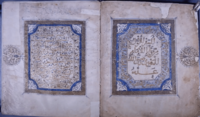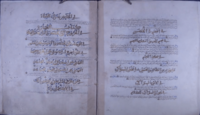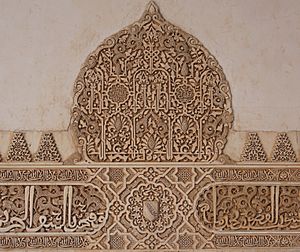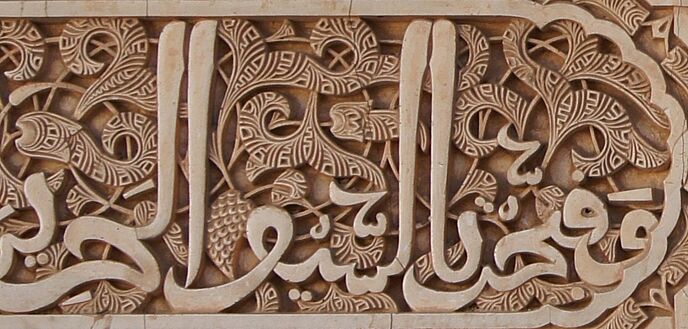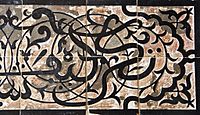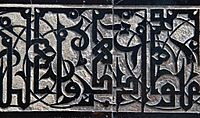Maghrebi script facts for kids

Maghrebi script (also called Maghribi script) is a group of Arabic script styles. These styles developed in North Africa (the Maghreb), al-Andalus (parts of Spain and Portugal), and the West African Sahel. Maghrebi script comes from the older Kufic script. It is usually written with a pointed pen, which makes the lines have an even thickness.
This script has round letter shapes. Its horizontal lines are often stretched out. Also, some letters have open curves that go below the main writing line. Maghrebi script is different from scripts used in the Middle East (called Mashreqi scripts). For example, the letters faa (Maghrebi: ڢ ; Mashreqi: ف) and qoph (Maghrebi: ڧ ; Mashreqi: ق) are written differently.
For many centuries, Maghrebi script was used to write Arabic manuscripts. It was also used for literature from al-Andalus and Morocco. This included texts in Classical Arabic, Maghrebi Arabic, and Amazigh languages.
Contents
History of Maghrebi Script
How Maghrebi Script Started
Arabic script first arrived in North Africa during the Islamic conquests (643–709 AD). The early conquerors used both Hijazi and Kufic scripts. You can see this on coins from that time. Maghrebi script directly comes from the old Kufic script. This was before a famous calligrapher named Ibn Muqla created standard rules for Mashreqi scripts.
As Islam spread, the Arabic script (especially the Iraqi Kufic style) also spread. Important cities like Fes, Cordoba, and Qairawan became centers for studying and copying the Qur'an. A special Kufic style, called Qayrawani Kufic, developed in al-Qayrawan.
African and Andalusi Styles
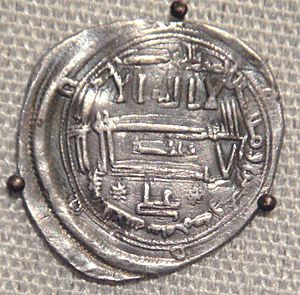
Early on, Maghrebi script had two main styles: the African script and the Andalusi script. The African script grew in Ifriqiya (modern Tunisia) from Iraqi Kufic. The Andalusi script developed in Iberia (Spain and Portugal). It came from the Damascene Kufic script. This happened when the Umayyad state was set up in Córdoba. The Andalusi script was known for its rounded letters. The African script spread across the Maghreb before the Andalusi script became widespread.
In Morocco, the script developed on its own under the Idrisid dynasty (788–974). It was influenced by Iraqi Kufic, which was used on Idrisid coins.
Support from Rulers
Almoravid Dynasty
Under the Almoravid dynasty, the Andalusi script spread throughout the Maghreb. However, the Jerīd region kept the African script. A fancy version of Kufic script also appeared during this time. You can see examples of Almoravid Kufic at the University of al-Qarawiyyin, the Almoravid Qubba, and the Almoravid Minbar.
The Kufic script on the Almoravid dinar coins was even copied on coins made by Alfonso VIII of Castile. The minbar (pulpit) of the al-Qarawiyyin Mosque, made in 1144, shows a style now called Maghrebi thuluth. This was a local version of Eastern thuluth and diwani scripts.
Almohad Dynasty
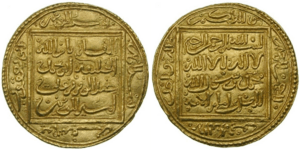
Under the Almohad dynasty, Arabic calligraphy continued to grow. Many different styles developed. The Almohad rulers, who were often interested in Arabic script, supported professional calligraphers. They invited scribes from al-Andalus to live in cities like Marrakesh, Fes, Ceuta, and Rabat. One Almohad ruler, Abu Hafs Umar al-Murtada, even started the first public center for copying manuscripts. This was at his mosque in Marrakesh.
The Maghrebi thuluth script became an official style for the Almohad rulers. It was used on books, coins, and fabrics. The Almohads also made certain words or phrases stand out by using gold leaf and lapis lazuli (a blue stone).
For centuries, Maghrebi script was used to write Arabic manuscripts. These books were traded all over the Maghreb. In the 11th century, there were 104 paper mills in Fes. By the 12th century, there were 400!
Nasrid Dynasty
In the Emirate of Granada, under the Nasrid dynasty, Arabic writing on buildings and monuments became very advanced. Especially under rulers Yusuf I and Muhammad V, Kufic writing developed long vertical lines that formed decorative knots. Kufic script also had a huge influence on Christian art.
"And the peninsula was conquered with the sword"
Aljamiado Script

In Iberia, Arabic script was also used to write European languages. These included Mozarabic, Portuguese, Spanish, or Ladino. This writing system was called Aljamiado.
Fesi Andalusi Script
Many people moved from Iberia to North Africa over time. This greatly affected writing styles there. The famous historian Ibn Khaldun noted that the Andalusi script improved under the Marinid dynasty (1244–1465). This was because Fes received many refugees from al-Andalus.
The Fesi script became popular in many cities like Fes, Ceuta, Taza, Meknes, Salé, and Marrakesh. However, it was less developed in rural areas. During the Marinid period, Maghrebi script mostly reached its final form. It became separate from the Andalusi script. There were three main forms of Maghrebi script then: one for cities, one for rural areas (used for both Arabic and Amazigh), and one that kept Andalusi features. Maghrebi script also had different types, including Kufic, mabsūt, mujawhar, Maghrebi thuluth, and musnad.
Saadi Reforms
The Saadi period (1549–1659) brought changes to how manuscripts were made and how calligraphy was taught. The Saadis set up centers for learning calligraphy. Sultan Ahmad al-Mansur himself was skilled in Maghrebi thuluth. He even created a secret script for his private letters! Fancy scripts became very popular under the Saadi dynasty. They were used in buildings, books, and on coins.
Alawi Era
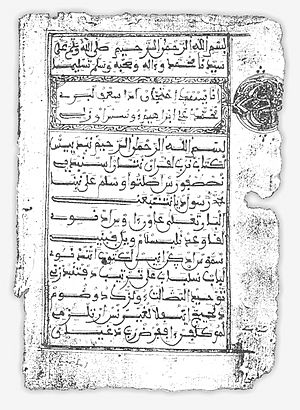
The Alawite sultans Al-Rashid and Ismail supported Maghrebi script in the 17th century. Later, under Sultan Muhammad III, the script became less refined, especially in rural areas. However, under Sultan Suleiman, the script improved in cities like Meknes. Some rural areas also became very good at Maghrebi script.
Later, the script's quality declined again. This led Ahmed ibn Qassim ar-Rifā'ī ar-Ribātī to start a movement to improve and standardize Maghrebi script. He wrote a book about the rules of Maghrebi script.
In the 19th century, Muhammad Bin Al-Qasim al-Qundusi created a unique style called al-Khatt al-Qundusi. When the first Arabic lithographic printing press came to Morocco in 1864, the mujawher style of Maghrebi script became the standard for printing books.
Colonial Period
The French Protectorate in Morocco caused problems for Maghrebi script. Latin script became more common in schools and public life. The Moroccan Nationalist Movement worked to protect Maghrebi script in response. In 1949, a series of booklets was published to teach Maghrebi script. Also, books from the Middle East, printed in naskh script, were brought in for schools. This led to handwriting being taught with Middle Eastern letter shapes.
After Independence
After Morocco gained independence, there were efforts to update Arabic script for typewriters. One important effort was by the Moroccan linguist Ahmed al-Akhdar al-Ghazal. He worked on a Standard Arabic Script.
Recent Developments
In 2007, a book called Maghrebi Script: History, Present, and Horizons was written about the script. The next year, the Muhammad VI Prize for the Art of Maghrebi Script was created to honor this art form. In early 2020, the President of Tunisia, Kais Saied, gained attention for writing official letters in Maghrebi script.
Types of Maghrebi Script
The book al-Khat al-Maghrebi lists five main types of Maghrebi script:
- Maghrebi Kufic (كوفي مغربي): These are different styles of Kufic script used in the Maghreb and al-Andalus.
- Almoravid Kufic (كوفي مرابطي): A decorative script used on coins, often with flower designs. The Almoravid minbar in Marrakesh has a great example.
- Almohad Kufic (كوفي موحدي)
- Marinid Kufic (كوفي مريني)
- Alawite Kufic (كوفي علوي)
- Qayrawani Kufic (كوفي قيرواني)
- Pseudo Kufic (شبه كوفي)
- Mabsout (مبسوط) script: Used for the main text in books and for writing the Qur'an. It's similar to the Eastern Naskh script.
- Andalusi Mabsout
- Saadi Mabsout
- Alawite Mabsout
- Mujawher (مجوهر) cursive script: Mainly used by kings to announce laws. This style became the standard for printed books when lithographic printing started in Fes.
- Thuluth Maghrebi (ثلث مغربي) script: Inspired by the Eastern Thuluth script. It's mostly used for decoration, like book titles and mosque walls. The Almohads used it as an official script.
- Musnad (مسند) script, or Z'mami (زمامي) script: A cursive script used by courts and notaries for things like marriage contracts. It comes from Mujawher. Its letters lean to the right. Because it's hard to read, it was sometimes used for texts that authors wanted to keep secret.
In the 19th century, Muhammad Bin Al-Qasim al-Qundusi created a fancy style called Qandusi (قندوسي) script.
A French scholar named Octave Houdas studied Maghrebi script in the 19th century. In 1886, he identified four main types:
- Qairawani—"smooth and even"
- Andalusi—"small, compact, and jerky"
- Fasi—"large, round, and elegant"
- Sudani—"thicker and blacker"
West African Maghrebi Scripts
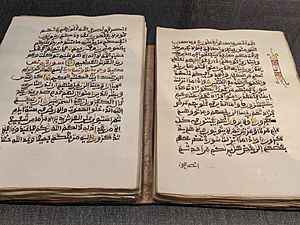
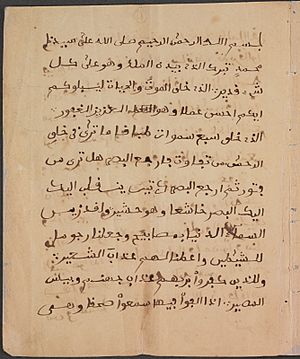
Several West African Arabic scripts are also part of the Maghrebi script family. They are sometimes called Sudani scripts. These include:
- Suqi (سوقي): Named after the town of Suq, also used in Timbuktu. It's linked to the Tuareg people.
- Fulani (فولاني)
- Hausawi (هاوساوي)
- Mauretanian Baydani (بيضاني موريطاني)
- Kanemi (كنيمي) or Kanawi: Linked to the region of Kano in modern Chad and northern Nigeria, and to Borno (also called Barnawi script).
- Saharan
How Maghrebi Scripts Are Different from Mashreqi Scripts
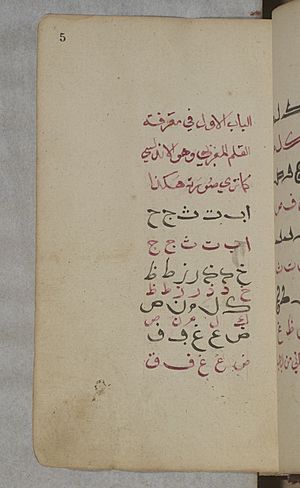
One main difference between Maghrebi scripts and scripts from the Middle East (Mashreqi scripts) is how the letters faa (ف) and qoph (ق) are dotted. In Mashreqi scripts, the faa has a circle with one dot above it. In Maghrebi scripts, the dot is below the circle (ڢ). For qoph, Mashreqi scripts use a circle with two dots above. Maghrebi qoph uses a circle with only one dot above (ڧ), similar to the Mashreqi faa.
Other differences in Maghrebi script include:
- The loop of Ṣād (ص) and Ḍād (ض) does not have a "tooth."
- The top parts of letters like alif (ا), lam (ل), lamalif (لا), Ṭāʾ (ط), and Ẓāʾ (ظ) have a knot at the end.
- The top parts of Ṭāʾ (ط) and Ẓāʾ (ظ) are drawn diagonally.
- The final alif (ـا) is written from top to bottom.
- The final and separate dāl (د) and dhāl (ذ) look like the beginning or middle forms of Kaph (كـ).
Also, Maghrebi scripts are traditionally written with a pointed pen. Mashreqi scripts use a chisel-tipped pen. This means Maghrebi scripts usually have less difference in line thickness. Mashreqi scripts have wider horizontal strokes and thinner vertical strokes.
Gallery
- Qurans in Maghrebi scripts
-
The Zirid "Nurse's Quran." Qairawan, early 11th century.
-
A page of the Pink Quran with illuminated diacritics. Al-Andalus 14th century.
-
Al-Fatiha in the Sudani script. North-west Africa, 19th century. Chester Beatty Library
See also
 In Spanish: Caligrafía magrebí para niños
In Spanish: Caligrafía magrebí para niños
- Rashi script
- Tifinagh



